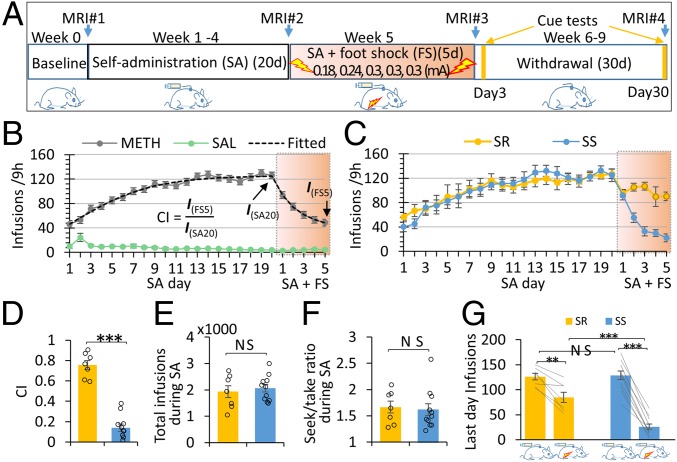Fig. 1.
Experimental design and behavioral results. (A) Two groups of rats METH (n = 18) and SAL (n = 11) experienced four distinct conditions designed to model the addiction cycle: baseline, SA training (9 h/d for 20 d, FR-1, 0.1 mg/kg per infusion of METH/SAL), SA plus foot shock, and withdrawal (cue-reactivity tests performed on withdrawal days 3 and 30). MRI data were collected at the end of each phase. (B) The METH SA rats increased lever pressing during the SA development phase (one-way ANOVA, P < 0.001 for both groups), and SA behavior decreased when foot shocks were introduced (one-way ANOVA, P < 0.001 for both groups). Drug intake was computationally modeled, and the estimated infusion on the last punishment day was normalized to that on the last SA development day to define a CI. (C) K-mean clustering on the CI differentiated METH rats into SR (n = 7) and SS (n = 11) subgroups. While both subgroups reduced drug taking after shock imposition, the SR but not the SS subgroup “recovered” and took more drug after the second shock day. There was no difference in SA behavior between the two subgroups before shock imposition. (D) The SR group showed significantly higher CI than the SS subgroup. (E) The total number of drug infusions during the SA development phase did not predict the subsequent categorization of SR and SS rats. (F) The total number of lever presses normalized by drug infusions (seek/take ratio) during SA phase did not differ between subgroups. (G) While both SS and SR rats significantly reduced drug intake at the end of SA+FS phase, the SR group took more drug than did the SS group, although there was no difference between them at the end of SA phase. #P < 0.1; *P < 0.05; **P < 0.01; ***P < 0.001; NS, not significant; error bar stands for SEM.

